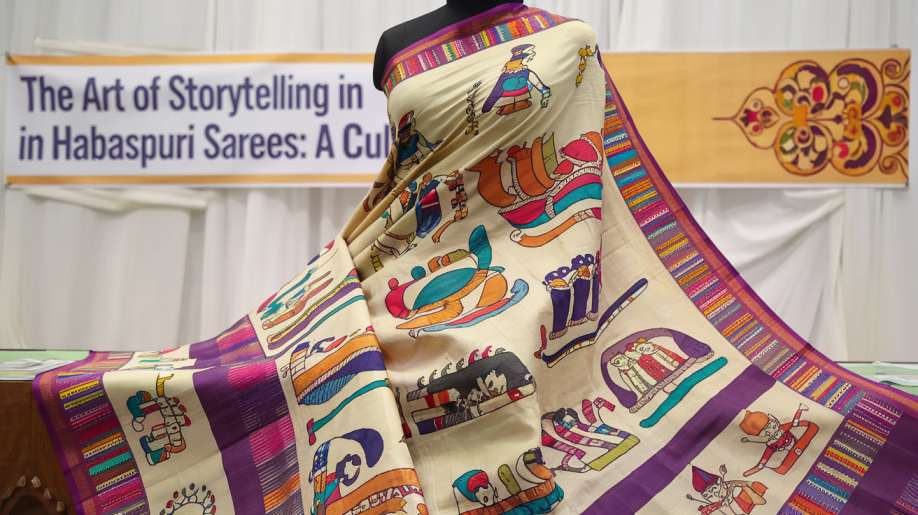A Habaspuri Sarees as a Form of Storytelling
Sarees are more than just garments; they are a rich tapestry of culture, history, and personal stories. Among the myriad varieties that adorn the Indian landscape, Habaspuri sarees are an exquisite example of traditional craftsmanship intertwined with narratives that resonate through time. Originating from the small town of Habaspur in Odisha, these sarees encapsulate the essence of the region’s heritage, telling tales of artistry, devotion, and women’s everyday lives.
Fascinating History of Habaspuri Sarees
Habaspuri sarees boast a history that dates back several centuries. They are handwoven using a technique that combines artistry with meticulous craftsmanship. These sarees, often made of cotton or silk, are renowned for their vivid hues, elaborate patterns, and distinctive motifs that capture the essence of Odisha’s rich culture.
Families of weavers have passed down the art of weaving Habaspuri sarees through generations. Each saree embodies the skill and dedication of the artisans, who often draw inspiration from local folklore, nature, and their own life experiences. As a result, every piece tells a story, capturing the essence of the weaver’s thoughts and emotions.
A Dance of Hands and Threads
Creating a Habaspuri saree is a beautiful blend of tradition and skill. It begins with selecting high-quality threads, often dyed using natural dyes sourced from local flora. The weaver meticulously plans the design, usually sketching intricate patterns that will later come to life on the loom.
As the weaving begins, it becomes a form of meditation for the artisan. Each shuttle movement is a rhythmic dance, echoing the weaver’s emotions and thoughts. The patterns are not just random; they often symbolize elements of nature or depict local legends. For example, floral motifs might represent growth and renewal, while geometric patterns can signify the interconnectedness of life.
The weaver unfolds her story through this process, transforming mere threads into a vibrant narrative that people can wear and cherish.
Stories Woven in Fabric
Habaspuri sarees are distinguished by their elaborate designs and motifs, each telling a unique tale. In Odisha, artisans often adorn the pallu—the decorative end of the saree—with elaborate designs featuring mythical creatures, gods, and goddesses and depictions of daily life.
One common motif is that of the lotus, a symbol of purity and beauty. In Indian culture, the lotus holds deep spiritual significance, often associated with deities like Lakshmi and Saraswati. By incorporating such motifs, the weaver infuses the saree with a sense of spirituality, allowing the wearer to connect with their cultural roots.
Other designs may reflect the weaver’s personal experiences or the stories passed down from their ancestors. For instance, a saree might showcase a scene from a local folk tale, bringing to life the narratives that have shaped the community’s identity over generations.
Emotions in Hues
Color is vital in Habaspuri sarees, adding depth to the storytelling. Every hue has a distinct cultural meaning and emotional weight.
- Red is popular for weddings and other celebratory occasions because it is frequently associated with love and fertility.
- Green symbolizes life and prosperity, while yellow represents knowledge and learning.
- Blue, linked to tranquility and peace, is often featured in sarees inspired by nature.
Additionally, the choice of color can reflect the wearer’s attitude and the message they wish to convey. A brighter palette may signify joy and celebration, while darker tones might narrate tales of struggle or resilience.
Wearing Stories
A woman donning a Habaspuri saree immerses herself in a story full of emotion and history rather than just wearing apparel. Each fold and drape carries the weight of stories that span generations, connecting the wearer to her ancestors and their experiences.
Wearing a Habaspuri saree can evoke a sense of nostalgia and pride. Many women recall stories their mothers or grandmothers shared about the sarees they wore during significant life events—weddings, festivals, or family gatherings. As a legacy passed down through the generations, the saree has become a treasured keepsake due to this emotional connection.
Preserving the Tradition
As global interest in sustainable fashion and handmade products grows, the future of Habaspuri sarees looks promising. We must actively support local artisans and preserve their craft for generations.
Efforts to promote handloom products, encourage fair trade, and train young weavers are vital in keeping this art form alive. Investing in these communities ensures that the stories woven into Habaspuri sarees remain alive, enriching our culture and connecting us to our roots.
Echoes of Elegance
Habaspuri sarees are more than just a form of clothing; they are a vibrant testament to the artistry and storytelling inherent in Indian culture. Each saree is a canvas of life, reflecting the emotions, experiences, and history of the weavers and their communities. As we celebrate these beautiful garments, we honor the narratives they carry, ensuring that the legacy of Habaspuri sarees continues to thrive in the hearts of many.


